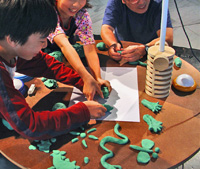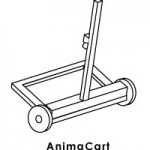Concept
 There are images all around us. However, there is always someone on the other side of the screen who makes those images for us. Do you ever think about that? In truth, making images is much, much more fun than simply watching them, and making animations is especially fun because is a certain primitive charm to animation in that you “make things move that should not move”.
There are images all around us. However, there is always someone on the other side of the screen who makes those images for us. Do you ever think about that? In truth, making images is much, much more fun than simply watching them, and making animations is especially fun because is a certain primitive charm to animation in that you “make things move that should not move”.
Up until now, workshops that let people experience the joys of animation were usually limited to simple flip-books, phenakistoscopes and other such primitive animation devices. However, since we are now in an age when computers can do so much with images, there are better approaches we can take. “I want a piece of equipment that I can use to make animations with things that are on hand like pencil and paper.” “Isn’t there some kind of device that will allow me to physically get into the world of video?” “I don’t want to toil away on my own. I want to make a place where everyone can work on animations together!”
With these ideas in mind, we have design several original devices, and are using them in workshops all over Japan.
Understand Animation in 1 Just Minute

If you use stop-motion, you can make an animation with as little as two pictures. We call this “2 koma-anime”, use it as our entry base for learning animation, and consider it to be a very important part of our workshop. Anyone can make a two picture stop animation in one minute. We use this in our workshops to try to get people to “directly experience the joy of animation withing the first minute.”
Make it Exciting

At first glance, a stop motion device looks a little bit like a piece of furniture or an old wooden toy, and there is a strange sense of wonder in trying to guess what the thing is used for. However, it is because the device looks odd that it makes people curious as to what it is. Once they understand what it is used for, it makes people want to try to use it themselves. We aim to make equipment that makes participants feel that same sense of excitement from the first moment they see it.
Trial and Error
 One more thing that we consider very important in our workshops is trying to lower the mental hurdle of messing up and having to start all over again. That is why we put a limit on the maximum number of stills you can shoot, and keep the length of the animations from getting too long. In our limited time, we try to have people repeat the trial and error process, while keeping a happy face. This approach is comparable to doing haiku or short poems in the world of literature.
One more thing that we consider very important in our workshops is trying to lower the mental hurdle of messing up and having to start all over again. That is why we put a limit on the maximum number of stills you can shoot, and keep the length of the animations from getting too long. In our limited time, we try to have people repeat the trial and error process, while keeping a happy face. This approach is comparable to doing haiku or short poems in the world of literature.
Animation Devices
Project team
- Taruto FUYAMA (Planning / Direction)
- Tadahiko SATO @ Trigger Device Ltd(Developing sensor and device / Producing)
- Takanori ENDO(Program / Sound Designing)
- Makoto IGUCHI(Programming)
- Takuya SAKURAGI(Product Designing)
